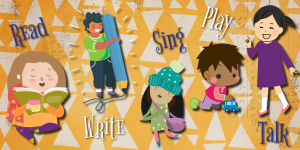
Scribbles are emergent writing. What is that?
Emergent writing is when children begin to understand that writing can communicate ideas using the scribbles they see around them. Children as young as two years begin to imitate writing by creating drawings and symbolic writings.
Children begin experimenting with writing by drawing and imitating writing. These may look like jagged lines or loops. The child is conveying a message and it will often accompany a picture. They want to share their story.
Children later move on to copying words they see around them and later drawing strings of letters. The letters are formed well, but there is no relationship to sound.
As children start to associate sounds with letters, they will branch away from copying and begin writing words based on their phonetic interpretation. Most often, these will be consonants without vowels. The word “alligator” may be written as “lgtr.” Names are important as well. Children take pride in knowing which letters make up their name and how to spell their name.
A child’s grasp of conventional spelling and phonics becomes stronger as they are exposed to other’s writing in the form of printed material and the writing they see from caregivers. Children will write longer text in the form of lists, stories, and descriptions.
Babies (0-18 months)
- Build those fine motor skills that will lead to writing and drawing! Laying out interesting objects for children to grab and hold will help develop finger dexterity.
Toddlers (18-36 months)
- Bring out writing materials and let them explore! Crayons, finger paints, large paint brushes, and washable markers are all options to allow your child. Young children are developing the motor skills that will build up to writing. Let their creativity shine as they hone their fine motor skills.
Preschoolers (3-5 Years Old)
- Let children play with magnetic letters and peg boards to trace the pre-formed letters with their fingers and become familiar with the letter forms. Just be careful they do not swallow any of the letters! As an edible option, you can cut out cookie cutter shapes of letters out of cheese or make alphabet sugar cookies.
- Spend time looking at the child’s favorite picture books and finding the letters in their name on the page. Ask them what other letters they see and what sounds those letters make.
Sources
- Dennis, L.R., & N.K. Votteler. 2013. “Preschool Teachers and Children’s Emergent Writing: Supporting Diverse Learners.” Early Childhood Education Journal 41 (6): 439–46.
- Rowe, D.W., & C. Neitzel. 2010. “Interest and Agency in 2- and 3-Year-Olds’ Participation in Emergent Writing.” Reading Research Quarterly 45 (2): 169–95.
- Byington, T A, and Y Kim. “Promoting Preschoolers Emergent Writing.” NAEYC, National Association for the Education of Young Children, Nov. 2017, www.naeyc.org/resources/pubs/yc/nov2017/emergent-writing.
-Megan, Children's Team at Kirk-Bear Canyon Library
 Read, Write, Talk, Sing, Play!
Read, Write, Talk, Sing, Play!
When children are given a chance to explore scribbling, draw pictures, and tell stories, they are learning reading skills. Being an active participant in writing helps keep children excited about reading stories.
Read more about early literacy and how you can make a difference in your child's life.


